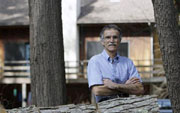VOA慢速英语2011--Retirement Savings Rule 1: Reduce Investment Risk as the Day Nears(在线收听)
Economics Report - Retirement Savings Rule 1: Reduce Investment Risk as the Day Nears
This is the VOA Special English Economics Report.
Today, retirement can mean different things. For many Americans, it means the end of the money-earning part of their life and the beginning of a period of enjoyment. But retirement calls for planning and savings.
In many countries, employers may offer some kind of retirement savings plan. The plan could be linked to the company’s stock or to a managed investment service. Almost any financial planner will say workers should use these plans to save money easily: often directly from their wages. But an employer plan should not be your only way to save for retirement.
Pete D’Arruda heads his own financial planning company and gives retirement advice on radio shows and television. He tells people to save whenever possible. But he says as retirement nears, you must take fewer financial risks.
PETER D’ARRUDA: “There’s three stages of life there when we look at it. There’s the part where you’re earning money. And when you’re earning money, if you have a salary, it makes it easier to take risk because you know that if you lose the money you can go back and earn some more.”
 |
| Robert Rivers of Ravena, New York, is among the baby boomers now starting to retire. |
By risks, Pete D’Arruda means investing in stocks and other financial instruments that can lose value quickly. He says people should move money away from riskier investments as they age even if there is a possibility of a higher rate of return. Instead, investors nearing retirement should seek more secure investments for their savings.
PETER D’ARRUDA: “But then we get to the transition phase when we’re within five years or so of retirement. I call it the financial red zone because now is the time when you need to protect what you have, you need to start transitioning away from the risk of Wall Street and into safe places that guarantee lifetime income.”
Pete D’Arruda has a simple way of deciding how much of your retirement savings should be at risk. He says, take your age and put a percentage after it. That is the percentage of your retirement savings that should be fully protected from losing value. So, for a sixty-five-year-old, the rule works like this:
PETER D’ARRUDA: “Sixty-five percent of the money must be in a place that can’t lose it. The reason why is when you’re in retirement it’s impossible to get the money back that you lost because you don’t have a salary coming in, so time is no longer on your side.”
The investment services company Charles Schwab prepares studies about Americans’ retirement planning. The company’s Retirement Pulse Survey looks at how people of all ages prepare for the big event.
One recent survey found that forty-four percent of baby boomers feel secure in their readiness for retirement. Baby boomers are the generation of Americans born in the years immediately after World War Two. The first baby boomers are now reaching sixty-five, currently the full retirement age in the United States.
And that's the VOA Special English Economics Report. I'm Mario Ritter.